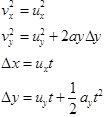Physics Formulae
Values are given to three significant figures, except where more are useful.
| speed of light in a vacuum | c | 3.00 × 108 m s–1 |
| permittivity of free space | ε0 | 8.85 × 10–12 C2 N–1 m–2 (F m–1) |
| elementary charge | e | 1.60 × 10–19 C |
| Planck constant | h | 6.63 × 10–34 J s |
| gravitational constant | G | 6.67 × 10–11N m2 kg–2 |
| Avogadro constant | NA | 6.02 × 1023 mol-1 |
| molar gas constant | R | 8.31 J mol-1 K–1 |
| Boltzmann constant | k | 1.38 × 10-23 J K–1 |
| electron rest mass | me | 9.11 × 10-31 kg |
| proton rest mass | mp | 1.673 × 10-27 kg |
| neutron rest mass | mn | 1.675 × 10-27 kg |
| alpha particle rest mass | ma | 1.646 × 10-27 kg |
| acceleration of free fall | g | 9.81 m s–2 |
Formula |
Name |
Comments |
|
Wave Equation |
v= velocity (m/s) |
|
Intensity Law |
I = intensity (no units) |
|
Snell’s Law |
v1 = speed in first medium
|
|
Electric Field |
E = Electric field (N/C, V/m) |
|
Ohm’s Law |
R = resistance (W) |
Energy = VIt |
Electrical Energy |
Energy (J) |
P=VI |
Electrical Power |
P = power (W) |
|
Average Velocity |
vav = average velocity (m/s) |
|
Average Acceleration |
|
|
Newton’s Second Law |
|
|
Kinetic Energy |
Ek = kinetic energy (J) |
|
Momentum |
P = momentum (Ns, kgm/s) |
|
Impulse |
Impulse = change in momentum (Ns, kgm/s) |
|
Universal Gravitation |
F = force (N) |
|
Kepler’s Third Law |
r = radius of motion (m) |
Gravitational Potential Energy |
Ep = Potential energy |
|
Gravitational Force |
F = force (N) |
|
 |
Newtons’ Laws of Motion |
ux = initial speed in x direction (m/s) |
| Kepler’s third law | r = radius of motion (m) |
|
| Relativistic Length Contraction | Lv = apparent length (m) |
|
 |
Relativistic time dilation | tv = apparent time (s) |
| Magnetic force on a current-carrying wire of length l in a magnetic field | B= Magnetic Field (T) I = current (A) l = length (m) |
|
| Force per unit length | F = force (N) l = length (m) per unit I1, I2 = two currents parallel=repulsive, antiparallel=attractive d = separation of the two currents (m) k=magnetic constant (2 X 10-7 NC-1m-1) |
|
| torque | t =torque (Nm) F =force (N) d=distance (m) |
|
torque on a coil immersed in a magnetic field |
t =torque (Nm) |
|
| Transformer equation | Vp = primary voltage (V) |
|
| Magnetic force on a charge in a magnetic field | F = force (N) |
|
| Electric Field | E = Electric Field (N/C, V/m) |
|
| Energy of a Photon | E = Energy (J) |
|
Wave Equation |
c = speed of light 3 X 108 m/s |
